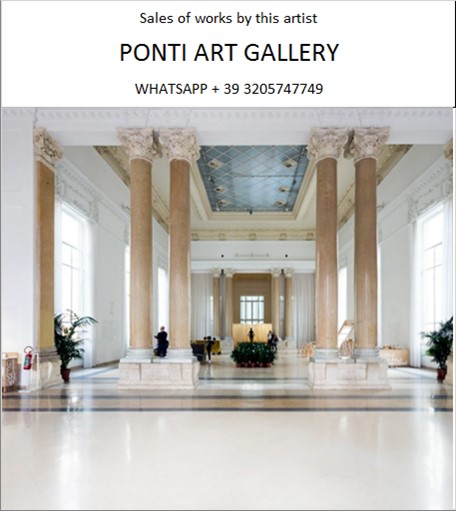Ponti Art Gallery is interested in buying and selling works
of art by this artist.

Lee Ufan Biography
Lee Ufan is a multifaceted artist whose work spans painting, sculpture, and critical writing, deeply rooted in philosophical inquiry and a minimalist aesthetic. Born on June 24, 1936, in Haman County, South Gyeongsang Province, Korea, during a time of Japanese occupation, Lee's early life was steeped in the traditional scholarly pursuits of calligraphy, poetry, and painting. His upbringing in a Confucian-style home instilled in him a profound connection to both the natural world and the scholarly arts, which would later inform his artistic practice.
Lee's initial foray into higher education began at Seoul National University's College of Fine Arts, where he studied painting. However, his journey took a pivotal turn when he moved to Japan in 1956, initially to visit relatives, but he decided to stay and continue his studies. In 1961, he graduated from Nihon University in Tokyo with a degree in philosophy. This academic background in Western philosophy, coupled with his Eastern heritage, created a unique foundation for his later work, which often explores the intersections of Eastern and Western thought.
In the late 1960s, Lee emerged as a leading figure in the Mono-ha movement, Japan's first contemporary art movement to gain international recognition. Mono-ha, which translates to "School of Things," rejected Western notions of representation and instead focused on the relationships between materials and perceptions. Artists associated with Mono-ha presented works made of raw physical materials that were minimally manipulated, if at all. Lee's contributions to Mono-ha were not only artistic but also theoretical, as he provided intellectual underpinnings for the movement with his dense yet poetic writings.
Lee's work is characterized by its simplicity and emphasis on the raw, unadorned presence of materials. One of his most iconic works from this period is "Phenomenon and Perception B" (1968), later renamed "Relatum," which consisted of a heavy stone placed on a sheet of glass atop a steel plate, causing the glass to crack. This piece exemplifies the Mono-ha interest in the interplay between natural and industrial materials and the relationships they form with their environment.
In the 1970s, Lee's artistic practice expanded to include painting, marking a transition from his earlier sculptural work. His painting series "From Point" and "From Line" (1973–84) utilized traditional Japanese Nihonga painting techniques, where ground mineral pigment mixed with animal-skin glue was applied in methodical brushstrokes. These works reflect a deep engagement with the act of painting itself, emphasizing the physicality of the brushstroke and its relationship to the canvas.
Lee's influence extended beyond Japan as he became a seminal figure in the Korean Dansaekhwa movement, also known as "Monochrome Painting." This style of painting, which emerged in the 1970s, shared similarities with Mono-ha in its focus on materiality and the creation of relationships between object, viewer, and space.
Throughout his career, Lee has been recognized with numerous accolades, including the prestigious Praemium Imperiale for painting in 2001 and the UNESCO Prize in 2000. His work has been exhibited in major institutions worldwide, such as the Guggenheim Museum in New York, the Royal Museums of Fine Arts of Belgium in Brussels, and the Yokohama Museum of Art in Japan.
Lee's impact on the art world is further cemented by the establishment of dedicated spaces for his work. The Lee Ufan Museum, designed by renowned architect Tadao Ando and opened in 2010 on Naoshima Island, Japan, is a testament to his legacy. The museum is a harmonious blend of nature, architecture, and art, offering a space for contemplation and engagement with Lee's oeuvre.
As a philosopher and artist, Lee has published several books, including "The Search for Encounter" and "The Art of Encounter," which delve into his artistic philosophy and the role of art in encountering the world. His writings and teachings have influenced generations of artists and thinkers, and his role as a professor at Tama Art University in Tokyo from 1973 to 2007 allowed him to directly shape the discourse around contemporary art in Japan.
Today, Lee Ufan continues to live and work between Kamakura, Japan, and Paris, France. His art remains a profound exploration of the relationships between space, materials, and perception, inviting viewers to engage with the essence of existence through a minimalist lens. His work challenges us to consider the fullness of emptiness and the resonance of silence, making him one of the most significant artists of our time.
Lee Ufan Quotes and Sales of
Works
Ponti Art Gallery selects and deals with paintings by the
artist. Upon request, we provide free estimates and
evaluations, communicate prices, quotations, and current
market values.
If you are interested in BUYING or SELLING works by the
artist, contact us immediately.
If you wish to sell or receive an evaluation of the
works:
Send us a frontal photo of the painting, one of the back,
and one of the signature. Also, indicate the dimensions of
the work. Inform us about the purchase origin of the work
and any kind of available documentation (purchase
receipts, certificates of authenticity, publications). One
of our operators will respond to you on the same day. We
guarantee maximum confidentiality and extreme
professionalism.
If you wish to purchase works by the painter: Contact us
and let us know your request. We will inform you about the
available works. We also offer the possibility to
subscribe to our NEWSLETTER, through which you will be
informed at the beginning of each month about the latest
acquisitions of the art gallery.
You can send us pictures of the work:
